| “Intelligence is not linked to the Y chromosome; to exclude half the population from scientific inquiry is to deny us, as a nation, an extraordinary amount of ability and intelligence.” |
| The Door in the Dream by Elga R. Wasserman Joseph Henry Press, 2000 |
 |
| Women Medical School graduates, 1938 |
This exhibit is a tribute to all of the women who have helped make Washington University School of Medicine the preeminent institution that it is today. At the start of the 21st century, the challenge before us is not only to maintain our excellence but also to go forward faster and more brilliantly than before. The best possible way to do this, of course, is to utilize all of our available human potential, male or female, to push back scientific and medical frontiers. Sometimes, though, we can go forward faster by recognizing where we’ve been. Toward this end, exploring women’s roles in these disciplines over the years may aid in the evaluation of persisting problems and/or new levels of complexity in attaining equity.
| “The women who were born in the early part of the 20th century faced enormous difficulties and frustrations. They were told at every turn that they did not belong in science. Most felt lucky if they found positions working as research assistants to established male scientists that provided them with a modest income and an opportunity to work in a laboratory.” |
| The Door in the Dream by Elga R. Wasserman Joseph Henry Press, 2000 |
Many women at the turn of the 20th century were barred from careers in science and medicine due to the lack of educational and employment opportunities. As educational opportunities improved, women moved into these fields but received little recognition. In large part, they served anonymously for token salaries in technical, associate or house staff roles. As the century progressed, however, two world wars provided brief windows of opportunity for women. But real change came in the 1970s when legal measures and policies based on equity considerations such as Title IX of the Education Amendment, affirmative action guidelines and the women’s movement fostered a sea change in the numbers of women entering scientific and medical fields.
| “Although institutions today encourage and support women’s participation, few have adapted their policies and schedules to the changing structure off contemporary families. They ignore expectations and policies that, although neutral on their face, disadvantage women by not taking the realities of their lives into account. In this respect, relatively little progress has been made…” |
Today, women at this institution and nationwide work in a vastly different climate. Today, gender-neutral policies are the norm. Despite these changes, however, women as a group still progress through the ranks more slowly than their male counterparts, and, given the paucity of women at the top, some would argue that a glass ceiling is still in place.
 |
| Pathology Department, 1939; Margaret G. Smith, seated front row. |
This exhibit is a selection of some of the pioneers at Washington University School of Medicine who began their careers in the 1920s, 1930s, 1940s and 1950s. These women were drawn to science and medicine because they loved the challenge and excitement of exploring the unknown or because they were passionately committed to seeking better ways to treat their patients. In order to achieve success, however, they had to overcome more obstacles than their male colleagues faced. Many were denied educational opportunities, employment opportunities, salaries commensurate with their job titles, career advancement or timely recognition. Many were told over and over again that women did not belong in science or medicine, or that they were taking a spot that belonged to a man. Somehow, they persisted and prevailed. Each individually found ways to ignore overt gender bias or marginalization. Each succeeded in having her abilities recognized and respected. Each has left a unique legacy, and, to those who follow, the encouragement to do the same.
| Despite many barriers, women all over the world have participated in unraveling the secrets of nature since the dawn of civilization. “The question is not why there haven’t been more women in science; the question is rather why we have not heard more about them.” |
| … Science historian Naomi Oreskes |
| Women Nobel Laureates in Science and Medicine | |
|---|---|
| Marie Sklodowska Curie | 1903 Physics |
| Marie Sklodowska Curie | 1911 Chemistry |
| Irène Joliot-Curie | 1935 Chemistry |
| Gerty Radnitz Cori* | 1947 Physiology or Medicine |
| Maria Goeppert Mayer | 1963 Physics |
| Dorothy Crowfoot Hogkin | 1964 Chemistry |
| Rosalyn Sussman Yalow | 1977 Physiology or Medicine |
| Barbara McClintock | 1983 Physiology or Medicine |
| Rita Levi-Montalcini* | 1986 Physiology or Medicine |
| Gertrude B. Elion | 1988 Physiology or Medicine |
| Christiane Nüsslein-Volhard | 1995 Physiology or Medicine |
| Linda B. Buck | 2004 Physiology or Medicine |
*Washington University School of Medicine Faculty |
|
 |
At the start of the 21st century, women remain a minority in the scientific disciplines.
This is not simply a “pipeline problem.” Women have composed 25 percent of all American medical school graduates since the early 1980s (AAMC) and over 40 percent of the life sciences graduates (NSF). At Washington University School of Medicine, the numbers have been even higher.
The overall number of women faculty at Washington University School of Medicine has increased from 14 percent in 1990 to 25 percent in 1997, where it has remained (2000).
Despite the increases, women are still disproportionately represented at the lower ranks.
In 2000, 75 percent of women faculty were in junior faculty positions vs. 46 percent of men. More than eight times as many male faculty (254) as female faculty (29) are represented at senior faculty levels.
Male and female faculty were promoted in similar proportions in 2000 (11 percent and 7 percent, respectively), but women were outnumbered more than 4 to 1 (103 males to 23 females).
 |
Women are significantly underrepresented in the upper ranks: there are only four women division chiefs vs. 49 men. There are no women department chairs.
In 1999, the “Study on the Status of Women Faculty in Science at MIT” concluded that the Massachusetts Institute of Technology had been guilty of marginalizing and systematically depriving tenured senior women of salary, space and resources. Other top research institutions are currently evaluating their programs to understand the prospects for their women scientists and clinicians in training. Similarly, at Washington University School of Medicine, the Office of Faculty Affairs was created to address needs pertaining to the entire faculty. Currently, this position remains unfilled.
